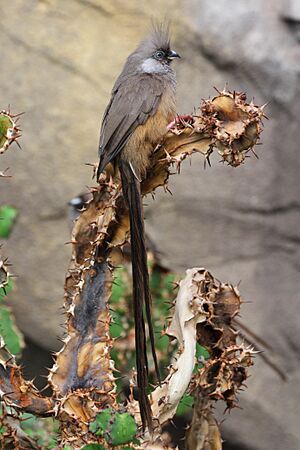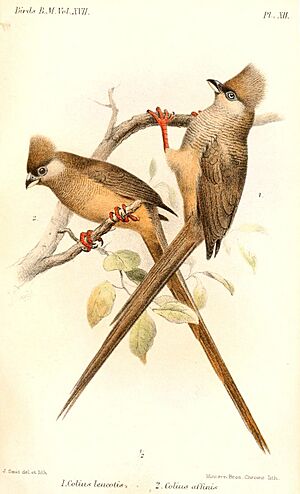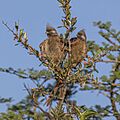Speckled mousebird facts for kids
Quick facts for kids Speckled mousebird |
|
|---|---|
 |
|
| Conservation status | |
| Scientific classification | |
| Genus: |
Colius
|
| Species: |
striatus
|
The speckled mousebird (scientific name: Colius striatus) is the biggest and one of the most common types of mousebird. You can find these birds across much of Central Africa, East Africa, and Southern Africa.
Contents
About the Speckled Mousebird
The speckled mousebird gets its name because its feathers look like a mouse's fur. It's about 35 cm (14 in) long, with its long tail making up about half of its body length. This bird weighs around 57 g (2.0 oz), which is about the same as a small apple.
Its body and head are a dull, mousy brown color, and it has a noticeable crest of feathers on its head. The top part of its bill is black, while the bottom part is a pinkish color. Different types of speckled mousebirds might have slightly different colors on their heads or throats, or different patterns on their feathers.
It's easy to tell the speckled mousebird apart from the rare white-headed mousebird. The speckled mousebird has different colored parts on its beak and doesn't have a bare grey patch around its eyes.
What Does a Speckled Mousebird Sound Like?
While speckled mousebirds aren't known for singing like songbirds, they are quite noisy. When they fly, they make a warbling tsu-tsu sound. If they sense danger, they use a sharp tisk-tisk call to warn others.
Where Speckled Mousebirds Live
You can find speckled mousebirds from Cameroon in the west, all the way east to Eritrea and Ethiopia. They also live south through eastern Africa down to southern South Africa, and they are common throughout Tanzania.
These birds can live in most places, but they usually avoid thick rainforests and very dry areas. They prefer open bushland and areas with lots of tangled bushes. You'll often see them in savannas and open woodlands. They are also common "backyard birds" and often visit gardens and fruit orchards in towns and cities.
How Speckled Mousebirds Behave
Speckled mousebirds are very social birds. They like to eat together and even groom each other's feathers. They also go to the ground together to take dust baths, which helps keep their feathers clean. Sometimes, they swallow small pebbles to help their stomachs grind up the plants they eat.
When night comes, these birds huddle together in very tight groups of about 20 birds. On cold nights, they can become "torpid," which means their body temperature and activity drop. This helps them save energy. Being torpid could make them easy prey, but being in a large group helps keep them safe from predators at night.
Reproduction and Life Cycle
Speckled mousebirds can have babies at any time of the year. Both the male and female birds work together to build their nest. It's a large, messy cup made from plants and sometimes even bits of cloth or paper.
A female mousebird usually lays between one and seven eggs, but most often, she lays three or four. The eggs hatch after about 14 days. Both parents feed the baby birds, and sometimes older brothers and sisters from previous nests also help out. The young birds leave the nest when they are about 17 or 18 days old. After a little over a month, the young mousebirds start finding their own food.
What Speckled Mousebirds Eat
Speckled mousebirds are mainly frugivores, which means they love to eat fruit. Their diet also includes berries, leaves, seeds, and nectar. They can be quite picky about what they eat, depending on what's available in their area.
Gallery





